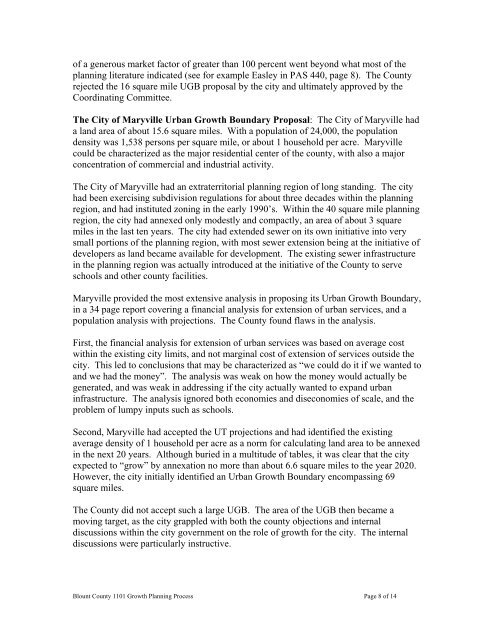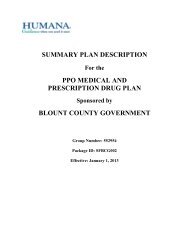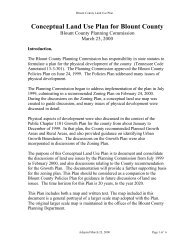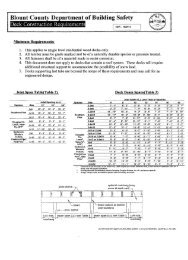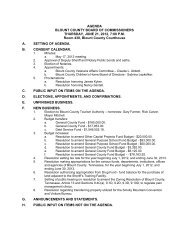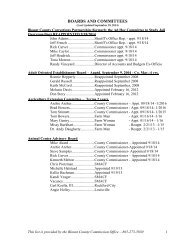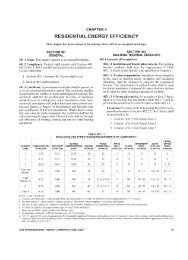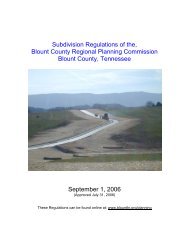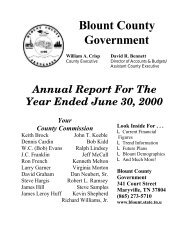Reflections on the 1101 Process in Blount County, Tennessee
Reflections on the 1101 Process in Blount County, Tennessee
Reflections on the 1101 Process in Blount County, Tennessee
You also want an ePaper? Increase the reach of your titles
YUMPU automatically turns print PDFs into web optimized ePapers that Google loves.
of a generous market factor of greater than 100 percent went bey<strong>on</strong>d what most of <strong>the</strong>plann<strong>in</strong>g literature <strong>in</strong>dicated (see for example Easley <strong>in</strong> PAS 440, page 8). The <strong>County</strong>rejected <strong>the</strong> 16 square mile UGB proposal by <strong>the</strong> city and ultimately approved by <strong>the</strong>Coord<strong>in</strong>at<strong>in</strong>g Committee.The City of Maryville Urban Growth Boundary Proposal: The City of Maryville hada land area of about 15.6 square miles. With a populati<strong>on</strong> of 24,000, <strong>the</strong> populati<strong>on</strong>density was 1,538 pers<strong>on</strong>s per square mile, or about 1 household per acre. Maryvillecould be characterized as <strong>the</strong> major residential center of <strong>the</strong> county, with also a majorc<strong>on</strong>centrati<strong>on</strong> of commercial and <strong>in</strong>dustrial activity.The City of Maryville had an extraterritorial plann<strong>in</strong>g regi<strong>on</strong> of l<strong>on</strong>g stand<strong>in</strong>g. The cityhad been exercis<strong>in</strong>g subdivisi<strong>on</strong> regulati<strong>on</strong>s for about three decades with<strong>in</strong> <strong>the</strong> plann<strong>in</strong>gregi<strong>on</strong>, and had <strong>in</strong>stituted z<strong>on</strong><strong>in</strong>g <strong>in</strong> <strong>the</strong> early 1990’s. With<strong>in</strong> <strong>the</strong> 40 square mile plann<strong>in</strong>gregi<strong>on</strong>, <strong>the</strong> city had annexed <strong>on</strong>ly modestly and compactly, an area of about 3 squaremiles <strong>in</strong> <strong>the</strong> last ten years. The city had extended sewer <strong>on</strong> its own <strong>in</strong>itiative <strong>in</strong>to verysmall porti<strong>on</strong>s of <strong>the</strong> plann<strong>in</strong>g regi<strong>on</strong>, with most sewer extensi<strong>on</strong> be<strong>in</strong>g at <strong>the</strong> <strong>in</strong>itiative ofdevelopers as land became available for development. The exist<strong>in</strong>g sewer <strong>in</strong>frastructure<strong>in</strong> <strong>the</strong> plann<strong>in</strong>g regi<strong>on</strong> was actually <strong>in</strong>troduced at <strong>the</strong> <strong>in</strong>itiative of <strong>the</strong> <strong>County</strong> to serveschools and o<strong>the</strong>r county facilities.Maryville provided <strong>the</strong> most extensive analysis <strong>in</strong> propos<strong>in</strong>g its Urban Growth Boundary,<strong>in</strong> a 34 page report cover<strong>in</strong>g a f<strong>in</strong>ancial analysis for extensi<strong>on</strong> of urban services, and apopulati<strong>on</strong> analysis with projecti<strong>on</strong>s. The <strong>County</strong> found flaws <strong>in</strong> <strong>the</strong> analysis.First, <strong>the</strong> f<strong>in</strong>ancial analysis for extensi<strong>on</strong> of urban services was based <strong>on</strong> average costwith<strong>in</strong> <strong>the</strong> exist<strong>in</strong>g city limits, and not marg<strong>in</strong>al cost of extensi<strong>on</strong> of services outside <strong>the</strong>city. This led to c<strong>on</strong>clusi<strong>on</strong>s that may be characterized as “we could do it if we wanted toand we had <strong>the</strong> m<strong>on</strong>ey”. The analysis was weak <strong>on</strong> how <strong>the</strong> m<strong>on</strong>ey would actually begenerated, and was weak <strong>in</strong> address<strong>in</strong>g if <strong>the</strong> city actually wanted to expand urban<strong>in</strong>frastructure. The analysis ignored both ec<strong>on</strong>omies and disec<strong>on</strong>omies of scale, and <strong>the</strong>problem of lumpy <strong>in</strong>puts such as schools.Sec<strong>on</strong>d, Maryville had accepted <strong>the</strong> UT projecti<strong>on</strong>s and had identified <strong>the</strong> exist<strong>in</strong>gaverage density of 1 household per acre as a norm for calculat<strong>in</strong>g land area to be annexed<strong>in</strong> <strong>the</strong> next 20 years. Although buried <strong>in</strong> a multitude of tables, it was clear that <strong>the</strong> cityexpected to “grow” by annexati<strong>on</strong> no more than about 6.6 square miles to <strong>the</strong> year 2020.However, <strong>the</strong> city <strong>in</strong>itially identified an Urban Growth Boundary encompass<strong>in</strong>g 69square miles.The <strong>County</strong> did not accept such a large UGB. The area of <strong>the</strong> UGB <strong>the</strong>n became amov<strong>in</strong>g target, as <strong>the</strong> city grappled with both <strong>the</strong> county objecti<strong>on</strong>s and <strong>in</strong>ternaldiscussi<strong>on</strong>s with<strong>in</strong> <strong>the</strong> city government <strong>on</strong> <strong>the</strong> role of growth for <strong>the</strong> city. The <strong>in</strong>ternaldiscussi<strong>on</strong>s were particularly <strong>in</strong>structive.<strong>Blount</strong> <strong>County</strong> <strong>1101</strong> Growth Plann<strong>in</strong>g <strong>Process</strong> Page 8 of 14


